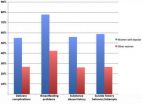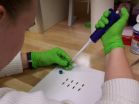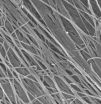(Press-News.org) PROVIDENCE, R.I. [Brown University] — Pregnant and postpartum women with bipolar disorder more frequently have significant mental health and early mothering challenges than other perinatal women undergoing psychiatric treatment, according to a study in the Journal of Affective Disorders. The findings indicate the importance of properly identifying the disorder and developing specific treatments for women during and after pregnancy, the lead author said.
"Similar to what you find with bipolar disorder in the nonperinatal population, the overall level of clinical severity and functional impairment really stands out as being of concern," said Cynthia Battle, associate professor (research) of psychiatry and human behavior in the Alpert Medical School of Brown University.
"It's a highly vulnerable time for these women," said Battle, who is also a psychologist at Butler Hospital and Women & Infants Hospital. "They have increased functional demands at this time."
Pregnancy often disrupts sleep and parenting a newborn can involve getting up several times a night for months, for example. Such sleep problems can potentially trigger new mood episodes among womenwith bipolar disorder, Battle said. Also, some women go off their medicines while pregnant out of concern for the health of the fetus, leaving their condition untreated.
Data of distress
To determine the clinical consequences of experiencing an acute disorder at a tricky time, Battle and her co-authors examined the records of 334 women diagnosed with a psychiatric disorder and seeking treatment at the Women & Infants Day Hospital Program, a perinatal-focused partial hospitalization program.
The results were published online in the journal Feb. 11.
Among the women, 32 were diagnosed with type I, type II, or unspecified bipolar disorder. All other patients were diagnosed with different psychiatric disorders, such as major depression, generalized anxiety, PTSD, or obsessive compulsive disorder.
Battle and her co-authors then conducted a statistical analysis of the records to compare how often the patients with bipolar disorder experienced important psychiatric and maternal problems, compared to women with the other disorders.
"Among those women who were diagnosed with BD, there was a significantly heightened risk for self-harm and impairment," the authors wrote.
Specifically, more than half of bipolar women had a history of substance abuse, compared to 26 percent of other patients, and 59 percent had a history of suicide attempts compared to 27 percent of other patients.
They also found that more than half of women with bipolar disorder had complications delivering their babies, compared to 27 percent of other patients. While a similar percentage of women with BD breastfed their infants, a larger proportion of the women with BD (78 percent) reported having trouble with breastfeeding, compared to 42.3 percent of other patients.
Toward therapy
Because of the serious clinical consequences associated with bipolar disorder, Battle said, providers need to watch carefully for mania symptoms of elation or irritability that distinguish bipolar disorder from depression.
"Often how people present for treatment when they have bipolar disorder is with the depressed mood, so it is important to assess for history of prior mania and also to ask about family history of mania," Battle said. "Asking those kinds of questions to help clarify whether this is unipolar depression vs. bipolar is going to be important to guide treatment."
Among women in the study not diagnosed with BD, 75 percent self-reported symptoms of irritability and 24.5 percent reported symptoms of elation.
Upon diagnosis, Battle said, the next question is "How can we best support women in making reasonable treatment decisions when faced with bipolar disorder during pregnancy?"
One option could be guiding patients to switch to medications that are safer during pregnancy or breastfeeding, so that they don't go off medications altogether. Connecting them to effective psychosocial therapies is also important.
Battle said she is part of a team working to develop a specialized psychosocial intervention for perinatal women with bipolar disorder.
INFORMATION:
In addition to Battle, other authors are Lauren Weinstock and Margaret Howard.
Partial support for the research came from the National Institute of Mental Health (grant K23MH079907).
Higher risks among perinatal women with bipolar disorder
2014-02-24
ELSE PRESS RELEASES FROM THIS DATE:
In the eye of a chicken, a new state of matter comes into view
2014-02-24
Along with eggs, soup and rubber toys, the list of the chicken's most lasting legacies may eventually include advanced materials such as self-organizing colloids, or optics that can transmit light with the efficiency of a crystal and the flexibility of a liquid.
The unusual arrangement of cells in a chicken's eye constitutes the first known biological occurrence of a potentially new state of matter known as "disordered hyperuniformity," according to researchers from Princeton University and Washington University in St. Louis. Research in the past decade has shown that ...
Watching how the brain works
2014-02-24
Coral Gables, Fla (Feb. 19, 2014) -- There are more than a trillion cells called neurons that form a labyrinth of connections in our brains. Each of these neurons contains millions of proteins that perform different functions. Exactly how individual proteins interact to form the complex networks of the brain still remains as a mystery that is just beginning to unravel.
For the first time, a group of scientists has been able to observe intact interactions between proteins, directly in the brain of a live animal. The new live imaging approach was developed by a team of ...
Costs vary widely for care of children with congenital heart defects across US hospitals
2014-02-24
Ann Arbor, Mich. – Costs of care differ significantly across hospitals for children born with heart defects, according to new research led by a University of Michigan researcher. Congenital heart defects are known to be the most common birth defects, impacting nearly 1 in every 100 births.
The cost of care for children with congenital heart disease undergoing surgical repair varied as much as nine times across a large group of U.S. children's hospitals, says lead author Sara K. Pasquali, M.D., M.H.S., associate professor of pediatrics at the University of Michigan Medical ...
Opioid abuse initiates specific protein interactions in neurons in brain's reward system
2014-02-24
(New York) – Identifying the specific pathways that promote opioid addiction, pain relief, and tolerance are crucial for developing more effective and less dangerous analgesics, as well as developing new treatments for addiction. Now, new research from the Icahn School of Medicine at Mount Sinai reveals that opiate use alters the activity of a specific protein needed for the normal functioning of the brain's reward center. Investigators were able to block the protein, as well as increase its expression in the mouse nucleus accumbens, a key component of the brain's reward ...
Abdominal fat accumulation prevented by unsaturated fat
2014-02-24
New research from Uppsala University shows that saturated fat builds more fat and less muscle than polyunsaturated fat. This is the first study on humans to show that the fat composition of food not only influences cholesterol levels in the blood and the risk of cardiovascular disease but also determines where the fat will be stored in the body. The findings have recently been published in the American journal Diabetes.
The study involved 39 young adult men and women of normal weight, who ate 750 extra calories per day for seven weeks. The goal was for them to gain three ...
Medical researchers use light to quickly and easily measure blood's clotting properties
2014-02-24
VIDEO:
This video shows the rapid "twinkling " or intensity fluctuations of the speckle pattern in a drop of unclotted whole blood. The rapid "twinkling " is due to the fast thermally-driven motion...
Click here for more information.
WASHINGTON, Feb. 24—Defective blood coagulation is one of the leading causes of preventable death in patients who have suffered trauma or undergone surgery. The body's natural defense against severe blood loss is the clotting ...
NIST microanalysis technique makes the most of small nanoparticle samples
2014-02-24
Researchers from the National Institute of Standards and Technology (NIST) and the Food and Drug Administration (FDA) have demonstrated that they can make sensitive chemical analyses of minute samples of nanoparticles by, essentially, roasting them on top of a quartz crystal. The NIST-developed technique, "microscale thermogravimetric analysis," holds promise for studying nanomaterials in biology and the environment, where sample sizes often are quite small and larger-scale analysis won't work.*
Chemical analysis of nanoparticles is a challenging task, and not just because ...
New biological scaffold offers promising foundation for engineered tissues
2014-02-24
Our cells don't live in a vacuum. They are surrounded by a complex, nurturing matrix that is essential for many biological functions, including growth and healing.
In all multicellular organisms, including people, cells make their own extracellular matrix. But in the lab, scientists attempting to grow tissue must provide a scaffold for cells to latch onto as they grow and proliferate. This engineered tissue has potential to repair or replace virtually any part of our bodies.
Typically, researchers construct scaffolds from synthetic materials or natural animal or human ...
Is previous hypoglycemia a risk factor for future hypoglycemic episodes?
2014-02-24
New Rochelle, NY, February 24, 2014—The automatic "threshold suspend" (TS) feature of an insulin pump helps prevent life-threatening hypoglycemic events when the device's sensor detects blood glucose concentrations below the preset threshold. However, in individuals with type 1 diabetes who have had previous episodes of hypoglycemia the TS feature may be less effective at preventing subsequent events, according to important new results from the ASPIRE study published in Diabetes Technology & Therapeutics (DTT), a peer-reviewed journal from Mary Ann Liebert, Inc., publishers. ...
Vitamin water: Measuring essential nutrients in the ocean
2014-02-24
The phrase, 'Eat your vitamins,' applies to marine animals just like humans. Many vitamins, including B-12, are elusive in the ocean environment.
University of Washington researchers used new tools to measure and track B-12 vitamins in the ocean. Once believed to be manufactured only by marine bacteria, the new results show that a whole different class of organism, archaea, can supply this essential vitamin. The results were presented Feb. 24 at the Ocean Sciences meeting in Honolulu.
"The dominant paradigm has been bacteria are out there, making B-12, but it turns ...







